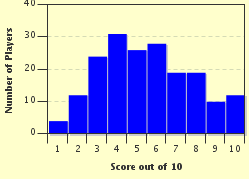Quiz Answer Key and Fun Facts
1. Which one of these major senses is not well developed in most species of dolphins?
2. Which of the following best describes the reproductive habits of the wild dog known as a dhole?
3. What is the term for the offspring of a male horse and a female donkey?
4. The dormouse is one of the few rodents who engage in which of the following behaviors?
5. What is the biggest difference between the dugong and the manatee?
6. What is the name of this black and white aquatic mammal?
7. The dingo was brought to Australia by European settlers.
8. In which of the following countries might you see a douc living in the wild?
9. The animal in the photo is known as a dromedary.
10. The dibatag derives its name from which of the following option?
Source: Author
dcpddc478
This quiz was reviewed by FunTrivia editor
Tizzabelle before going online.
Any errors found in FunTrivia content are routinely corrected through our feedback system.


